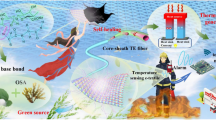Abstract
High-performance textile filament yarns, more precisely glass filament (GF) yarn, were used as base material for the development of sensor yarns (SY) because GFs offer high tensile strengths and moduli of elasticity in addition to beneficial decomposition temperatures and elongation. The aim of this work was the creation of a multifunctional sensor yarn (MFSY) based of GF. To achieve this aim, a homogeneous, completely coated first (1st) and second (2nd) silver (Ag) layer was built on the GF yarn surface by developing new technologies. The 1st Ag layer monitors damage within the thermoplastic composite globally, whereas the 2nd Ag layer monitors it locally and defects interface damage. Also, there was an insulation layer between two Ag layers, leading to a total of three layers built on the GF surface. Its surface morphology was determined by light and scanning electron microscopy (SEM) to assess Ag layer properties, such as structure, homogeneity, and cracking. For structural analysis, GFs were investigated using a Fourier transform infrared spectrometer (FTIR). The Ag layer thickness was determined after coating and metallization. Textile-physical tests of the GF in terms of tensile strength, elasticity modulus, elongation at break, yarn fineness and electric conductivity, were carried out before and after silvering.
Similar content being viewed by others
References
J. M. Berthelet, “Composite Materials”, Springer-Verlag. New-York, 1998.
A. Lund and B. Hagstroem, J. Appl. Polym. Sci., 116, 2685 (2010).
D. J. Leo, “Engineering Analysis of Smart Materials Systems”, Hoboken, p.128, p.142, pp.351–384, Wiley, New-York, 2007.
A. Talbourdet, F. Rault, A. Cayla, C. Cochrane, E. Devaux, A. Gonthier, G. Lemort, and C. Campagne, 17th AUTEX World Textile Conf., Greece, 531, 29–31 May, 2017.
C. Li, E. T. Thostenson, and T. W. Chou, Compos. Sci. Technol., 68, 1227 (2008).
H. Zhao, Y. Zhang, P. D. Bradford, Q. Zhou, F. G. Yuan, and Y. Zhu, Nanotechnology, 21, 305502 (2010).
X. H. Zhong, Y. L. Li, Y. K. Liu, X. H. Qiao, Y. Feng, J. Liang, F. Hou, and J. Y. Li, Adv. Mater., 22, 692 (2010).
S. Ali, A. Fernando, P. Potluri, and M. Gresil, 15th AUTEX World Textile Conf. Bucharest, Romania, 10–12 June, 2015.
F. Syrén, C. Li, E. Billing, A. Lund, and V. Nierstrasz, 16th AUTEX World Textile Confer., Ljubljana, Slovenja, 8–10 June, 2016.
G. Zhou and L. M. Sim, Smart Mater. Struct., 11, 925 (2002).
H. Zhang, U. Hassler, M. Genest, H. Fernandes, F. Robitaille, C. Ibarra-Castanedo, S. Joncas, and X. Maldague, Opt. Eng., 54, 104109 (2015).
C. Ibarra-Castanedo, J. M. Piau, S. Guilbert, N. P. Avdelidis, M. Genest, M. Bendada, P. Xavier, and V. Maldague, RNDE, 20, 1 (2009).
S. Vedula, Master Thesis, Clemson University, 2010.
N. Muto, Y. Arai, S. G. Shin, H. Matsubara, H. Yanagida, T. Naktsuji, M. Sugita, and T. Nakatsuji, Comp. Sci. Technol., 61, 875 (2001).
A. Horoschenkoff, T. Mueller, and A. Kroell, ICCM-17, Edinburgh, Scotland, 27–31 July, 2009.
A. Kunadt, E. Starke, G. Pfeifer, and Ch. Cherif, Tech. Mess., 77, 113 (2010).
Ch. Cherif, “Textile Werkstoffe für den Leichtbau: Techniken, Verfahren, Materialien, Eigenschaften”, ISBN: 9783642179914; 3642179916; 3642179924; 9783642179921, pp.63–71, Springer, Berlin, Heidelberg, 2011.
T. Onggar, M.M.B. Hasan, R. D. Hund, and Ch. Cherif, Technical Textiles, 3, E156 (2015).
T. Onggar, E. Häntzsche, A. Nocke, R. D. Hund, and Ch. Cherif, Smart Mater. Struct., 26, 045013 (2017).
German Institute for Standardization e.V., Norm DIN EN 54 345 T5, 1992.
German Institute for Standardization e.V., Norm DIN EN ISO 2060 1195, 1995.
German Institute for Standardization e.V., Norm DIN EN ISO 3314, 1992.
B. Wulfhorst, “Glass Fibers - Fiber Tables According to P. A. Koch”, Vol. 43/95, pp.21–32, Deutscher Verlag GmbH, Frankfurt, 1993.
D. A. Keyworth, Talanta, 4, 383 (1959).
L. Gmelin, “Handbuch der anorganischen Chemie, Silber, Teil B6: Komplexverbindungen mit neutralen und innerkomplexbildenden Liganden: Silber(I)-Komplexe mit N- und O-haltigen Liganden”, Vol. 8, pp.306–309, pp.225-233, Berlin Springer, Berlin, 1975.
P. Pollak and R. Vouillamoz in “Ullmann's Fine Chemicals” (B. Elvers Ed.), Vol. 1, p.169, Wiley-VCH, Weinheim, 2014.
N. Blaževic, D. Kolbah, B. Belin, V. Šunjić, and F. Kajfež, Synthesis, 3, 161 (1979).
D. J. Campbell, K. J. Beckman, C. E. Calderon, P. W. Doolan, R. M. Ottosen, A. B. Ellis, and G. C. Lisensky, J. Chem. Educ., 76, 537 (1999).
L. Gmelin in “Handbuch der anorganischen Chemie, Silber teil A3: Das Element, Technologie und Darstellung, Isotope, Atom, Molekeln, Physikalische Eigenschaften des Metalls. Teilchengröße und Teilchenzahl” (R. J. Meyer and P. Erich Eds.), Vol. 16, pp.208–210, Chemie Verlag, Weinheim, 1970.
H. N. Petersen, Y. Kusano, P. Brøndsted, and K. Almdal, 34th Risoe Int. Symp. Mater. Sci., 2–5 September, Roskilde, Denmark, 2013.
H. B. Bong, J. Korean Phys. Soc., 59, 3192 (2011).
R. C. Zhuang, T. Burghardt, and E. Maeder, Comp. Sci. Technol., 70, 1523 (2010).
K. Efimenko, W. E. Wallace, and J. Genzer, J. Colloid. Interface Sci., 254, 306 (2002).
B. Ahmed, S. K. Raghuvanshi, N. P. Sharma, J.B.M. Krishna, and M. A. Wahab, PNN, 2, 42 (2013).
German Institute for Standardization e.V., Norm DIN EN IS0 139, 2005.
Acknowledgments
The authors would like to thank the German Research Foundation [DFG CH174/40-1: Multifunctional sensor yarns for real time in situ sensing of multiple scale damage behaviour for the purpose of structural health monitoring of textile reinforced composites] for the financial support in terms of the research, authorship, and/or publication of this article.
Author information
Authors and Affiliations
Corresponding author
Rights and permissions
About this article
Cite this article
Onggar, T., Häntzsche, E., Hund, RD. et al. Multilayered Glass Filament Yarn Surfaces as Sensor Yarn for In-situ Monitoring of Textile-reinforced Thermoplastic Composites. Fibers Polym 20, 1945–1957 (2019). https://doi.org/10.1007/s12221-019-1237-2
Received:
Revised:
Accepted:
Published:
Issue Date:
DOI: https://doi.org/10.1007/s12221-019-1237-2




